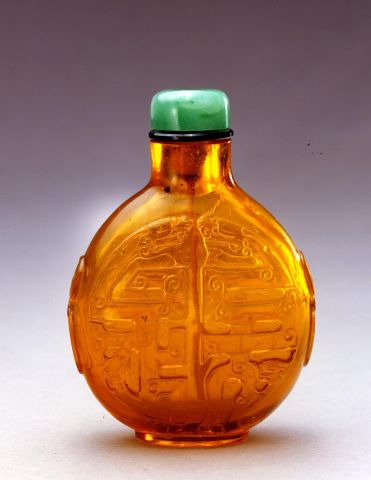
Bottle ID: 00145
YELLOW CLEAR, CARVED W/DRAGONS
Date: 1750-1800
Height: 57 mm
Glass, of rounded flattened form, the shoulders ascending to a slightly everted mouth, of transparent orange-yellow tones, carved on each side with four confronting archaic dragons forming a raised shou medallion design; the sides carved with mock mask and ring handles and with a neatly carved footrim.
Imperial, attributed to the Palace Workshops, Beijing.
Similar Examples:
Crane Collection no. 685.
Crane Collection nos. 305, 401 and 402
Moss, Hugh, Victor Graham and Ka Bo Tsang. A Treasury of Chinese Snuff Bottles - The Mary and George Bloch Collection, 2002, Vol. 5, Part 2, pp. 340-341, nos. 825 and 826; pp. 370-371, no. 842.
Stevens, Bob C. The Collector's Book of Snuff Bottles, 1976, pp. 64-65, no. 170.
Provenance:
Clare Lawrence Ltd.
Exhibited:
Annual Convention ICSBS Toronto, October 2007
The Archives of the Imperial Household Department during the Qianlong period list nine colors of yellow, of which one is described as 'golden amber'. This appears to match the color of the Crane bottle. The term 'Imperial yellow' to describe opaque yellow glass bottles has been a term long used by collectors in this field. Collectors of glass objects have tended to shy away from this term prefering to give an attribution to the Palace Workshops if applicable. Since the translation of the Archives, it is apparent that snuff bottle collectors should also follow the latter designation. A glass bottle such as the Crane bottle technically can be described as yellow and also as Imperial, but it would not be perceived today in the same manner as an opaque yellow glass bottle, or be called 'Imperial yellow', by collectors.
The term 'Imperial' when refering to works of art, including snuff bottles, has been widely used, but can be defined in a number of different ways. At the highest level it can mean 'for the use of the Emperor and his family'. Alternatively, it could mean 'for use in the Court' (for example by an official) or it could mean 'Made in the Palace Workshops'. Whatever the implied meaning, the use of the word 'Imperial' does serve to separate the piece to which it refers from the rest of the herd, implying a certain level of artistic sensibility and stellar quality.
< Back to full list
 English
English 中文
中文